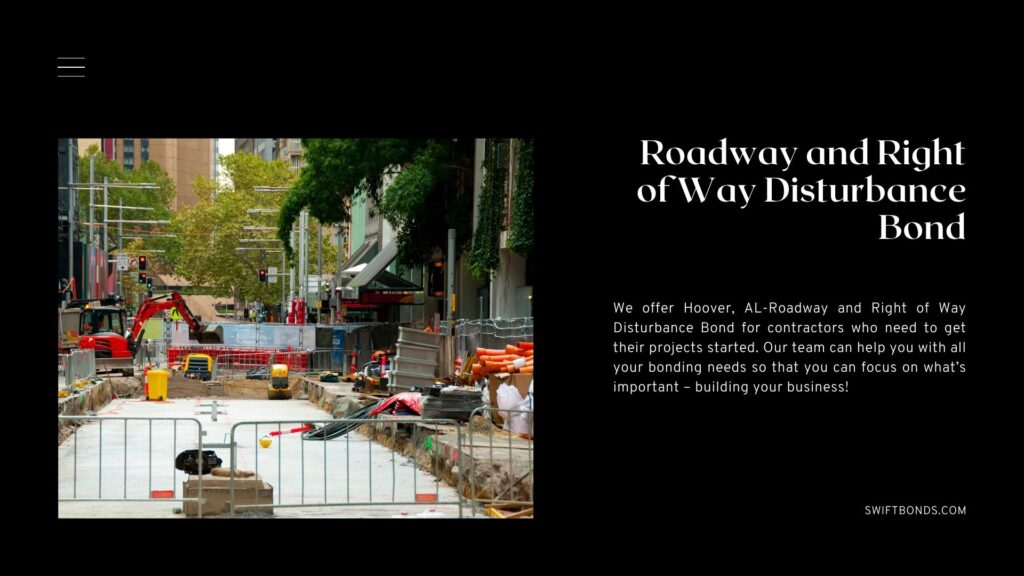

Get An Instant Quote on Hoover, AL-Roadway and Right of Way Disturbance Bond Now

Introduction
In the bustling city of Hoover, AL, infrastructure development is a continuous endeavor to support the growing needs of residents and businesses. However, with progress comes the responsibility to protect public assets and ensure the safety of roadways and right of ways. This is where the Roadway and Right of Way Disturbance Bond comes into play. Required by city authorities, this bond serves as a crucial safeguard to mitigate potential risks associated with roadway and right of way disturbances. In this article, we delve into the intricacies of the Roadway and Right of Way Disturbance Bond in Hoover, exploring its purpose, requirements, and implications for developers and the community.


Understanding the Purpose
The Roadway and Right of Way Disturbance Bond serves a critical purpose in protecting public infrastructure and ensuring the safety and functionality of roadways and right of ways in Hoover. By requiring developers to obtain this bond before commencing construction activities, the city mitigates the risk of damage to roads, sidewalks, utilities, and other public assets. Additionally, the bond helps ensure that developers comply with all necessary regulations and permits to minimize disruptions to traffic flow and pedestrian safety. Ultimately, it fosters responsible development practices and preserves the integrity of Hoover's infrastructure.
Requirements and Application Process
Obtaining a Roadway and Right of Way Disturbance Bond in Hoover involves meeting specific criteria set forth by city authorities. Developers typically undergo a thorough application process, which may include project plans, traffic control measures, and financial documentation. Additionally, they must secure the bond from a licensed surety company, with the bond amount determined based on the scope and scale of the construction project. By fulfilling these requirements, developers demonstrate their commitment to protecting public assets and ensuring the smooth execution of roadway and right of way disturbances.
Implications for Developers and the Community
For developers, the Roadway and Right of Way Disturbance Bond carries significant implications for their projects. It serves as a prerequisite for obtaining permits and approvals from the city and influences the overall feasibility and success of the development venture. Failure to maintain compliance with the bond requirements can result in fines, penalties, and delays in project completion. Conversely, for the community, the bond ensures that construction activities are carried out responsibly, minimizing disruptions to daily life and preserving the quality of public infrastructure.
Conclusion
As development activities continue to shape the landscape of Hoover, the Roadway and Right of Way Disturbance Bond remains a vital tool in safeguarding public assets and ensuring the safety of roadways and right of ways. By understanding its purpose, meeting the requisite requirements, and embracing its implications, developers can contribute to the long-term prosperity and vitality of Hoover. In doing so, they help create a city that is not only attractive for investment and growth but also safe and accessible for residents and visitors alike.
What is the Hoover, AL – Roadway and Right of Way Disturbance Bond?
The Roadway and Right of Way Disturbance Bond is a fundamental component of Hoover's regulatory framework for construction and development projects. But what exactly does this bond entail? Essentially, it is a form of surety bond required by the city to ensure that developers adhere to all relevant laws, codes, and regulations while undertaking activities that may disturb roadways or public right of ways. By obtaining this bond, developers provide financial security to cover potential liabilities or damages that may arise from their activities.
Frequently Asked Questions
Can the Roadway and Right of Way Disturbance Bond Cover Damage to Underground Utilities?
An uncommon question that may arise among developers in Hoover regarding the Roadway and Right of Way Disturbance Bond concerns its coverage for damage to underground utilities. Developers may wonder whether the bond extends to cover liabilities or damages resulting from accidental damage to underground utilities, such as gas lines, water pipes, or electrical conduits, during construction activities. The answer depends on the specific terms outlined in the bond agreement and the regulations set forth by the city. While some bonds may offer broad coverage for various roadway and right of way disturbances, others may require additional endorsements or separate bonds for claims related to underground utility damage. Developers should consult with their surety bond provider or city officials to clarify the coverage for damage to underground utilities.
Are There Provisions for Landscape Restoration Projects Under the Roadway and Right of Way Disturbance Bond?
Another less common inquiry pertains to the provisions for landscape restoration projects under the Roadway and Right of Way Disturbance Bond in Hoover. Developers may inquire whether the bond can provide coverage for expenses related to the restoration of landscaping, vegetation, or natural habitats disturbed during construction activities. This could include the replanting of trees, the installation of erosion control measures, or the rehabilitation of disturbed ecosystems. The applicability of bonds for landscape restoration projects often depends on the specific terms outlined in the bond agreement and the regulations set by the city. Developers should consult with city authorities and their surety bond provider to determine the bond's coverage for landscape restoration initiatives and ensure compliance with landscaping requirements.
Can the Roadway and Right of Way Disturbance Bond Extend to Cover Temporary Traffic Control Measures?
A lesser-known aspect that developers may inquire about is the extension of coverage under the Roadway and Right of Way Disturbance Bond to include temporary traffic control measures. Developers may wonder whether the bond can provide coverage for expenses related to the installation and maintenance of temporary traffic signs, signals, barricades, or flaggers required to safely manage vehicular and pedestrian traffic during construction activities. The applicability of bonds for temporary traffic control measures often depends on the specific terms outlined in the bond agreement and the regulations set by the city. Developers should consult with their surety bond provider or city officials to determine the bond's coverage for temporary traffic control measures and ensure compliance with traffic management requirements.




